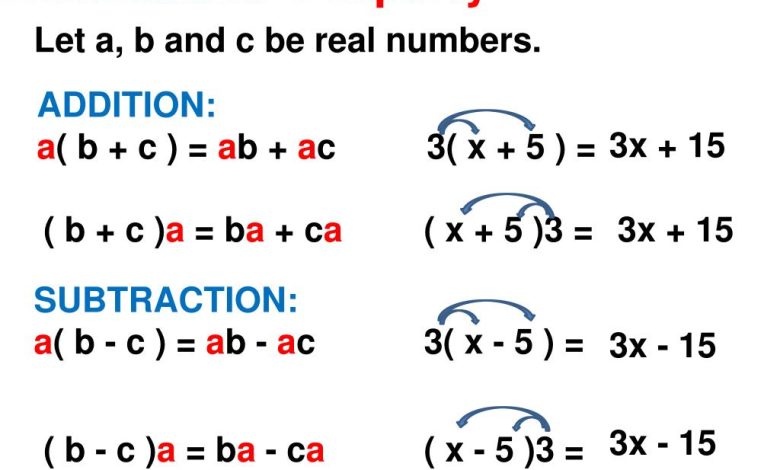Distributive Property – Definition & Examples

The distributive property is a way of multiplying two or more expressions that have the same variable.
What is distributive property?
The distributive property is a mathematical property of multiplication. It states that if the multiplication is performed on two or more groups of numbers, the product can be obtained by performing the same operation on each group and then adding up all the results.
For example, If you divided it into groups of 10 years, you would have $110.
property of multiplication
The property states that we can decompose the product of two or more numbers and distribute the multiplication over some or all of the summands.
The property is a mathematical law that says that if we have to multiply something by an algebraic expression that has more than one term then we can work out what it would be by multiplying all of the terms together or distributing our multiplication over different terms. This also states that we can decompose the product of two or more numbers and distribute the multiplication over some or all of the summands.
Property with Variables
The property is often used to reduce a fraction by distributing the first number. For example, 22/2*5=20/1*5=10
The distributive property is also used to multiply or divide two numbers that are multiplied together. For example, 2x(3×4)=2x(6)=[2*6]=12
This property can also be used with variables and there are some rules for these cases as well. For example, if you have two terms that are variables and you want to multiply them together the product will always be a variable unless we combine them with an operation or parentheses.
Distributive Property with exponent
The property is a common algebraic rule. the property is a mathematical rule, and it can be used to simplify the evaluation of expressions concerning both multiplication and addition.
The distributive property, in its most common form, states that
The following examples illustrate how to use the distributive property:
Sum of two numbers:
4 × 7 = 28.
4 × (7 + 3) = 28. Sum of two numbers:
4 + 7 = 11, so 4 × 7 = 44.
Distributive Property with a fraction
The property is a very useful tool for simplifying an expression with a fraction in the denominator. For example, 5(6+7) + 5
You can break it down as follows:
5(6) + 5×7, or
5×6+5×7.
To understand this property, you need to know how to multiply fractions. If there are two fractions, on the left and right of a multiplication sign, then you need to multiply all of the multiplicands together. In other words, for two fractions:
formula_1 formula_2
you would take their products and add them together to get:
formula_3 formula_4
examples of Property
There are three main examples of the property:
When multiplying an expression with two terms, such as 3(x+2), 3 must be multiplied by each term in the expression.
dividing an expression with two terms, such as 4(x+3), 4 must be divided by each term in the expression.
When adding an expression with two terms, such as 5(x+4), 5 must be added to each term in the expression. Some general examples of the distributive property are:
– A(B+C) = A*B + A*C = B*A + C*A
– (a+b) ˆ (a+b)=aˆ2 + bˆ2
– 5x(x+1) = 5x+5x




